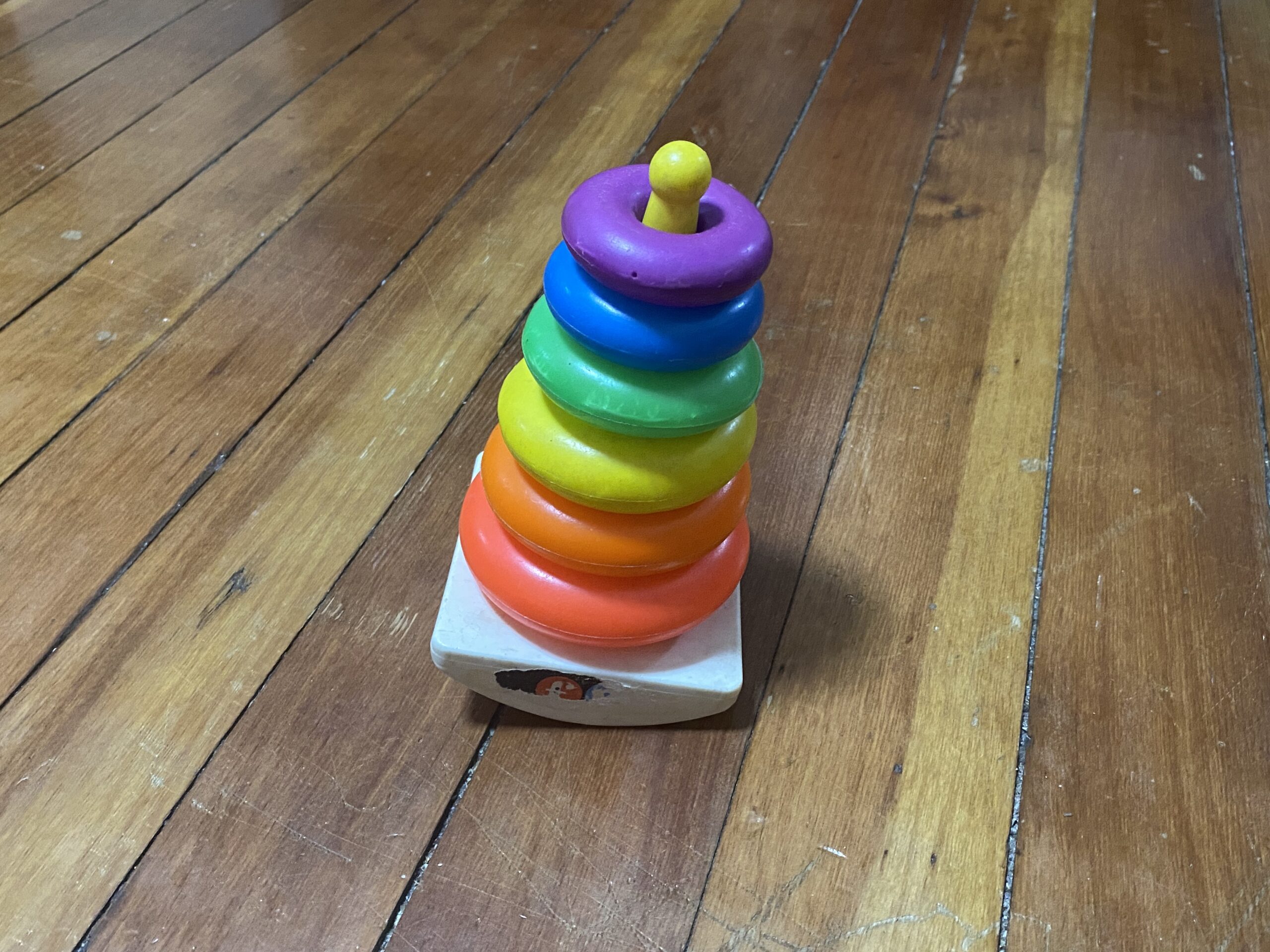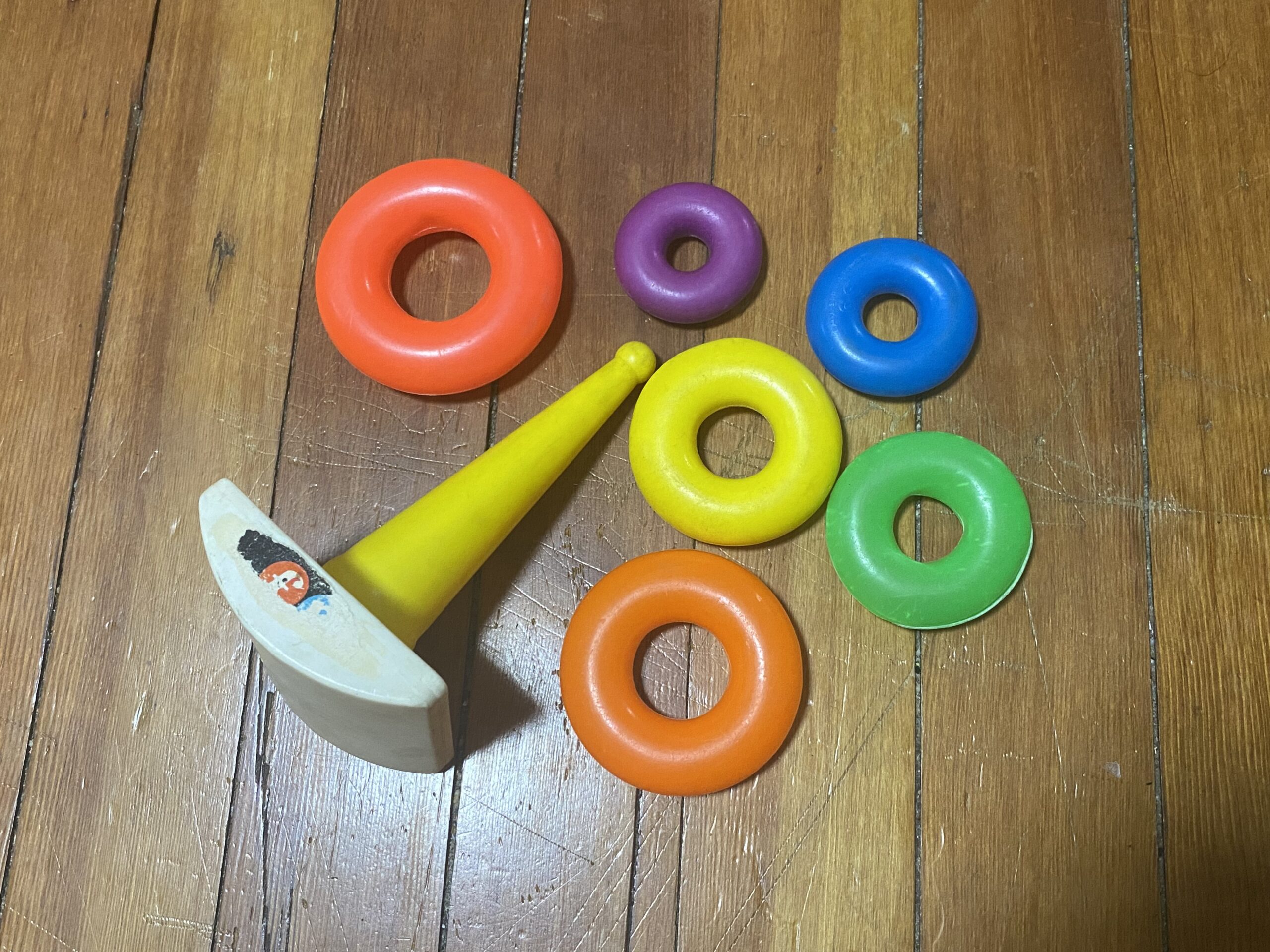XRF test results for vintage (1970s?) Fisher Price stacker toy… with ALL the bite marks! 4,289 ppm Lead, 517 ppm Arsenic & 18 ppm Cadmium
For those new to the Lead Safe Mama website:
Tamara Rubin is a multiple-federal-award-winning independent advocate for childhood Lead poisoning prevention and consumer goods safety, and a documentary filmmaker. She is also a mother of Lead-poisoned children (two of her four sons were acutely Lead-poisoned in 2005).
- Tamara owns and runs Lead Safe Mama, LLC — a unique community collaborative woman-owned small business for childhood Lead poisoning prevention and consumer goods safety.
- Since 2009, Tamara has been conducting XRF testing (a scientific testing method) using the exact instrumentation employed by the U.S. Consumer Product Safety Commission to test consumer goods for toxicants (specifically heavy metals — including Lead, Cadmium, Mercury, Antimony, and Arsenic).
- Since July of 2022, the work of Lead Safe Mama, LLC has been responsible for 5 product recalls (FDA and CPSC).
- Recent notable press… There has been too much to mention already in 2024! Please check out our press page to see some of the amazing coverage of our work so far this year!
This is an ad-free article.
Advertising and affiliate income help Lead Safe Mama, LLC cover the costs of the work we do here (independent consumer goods testing and childhood Lead-poisoning prevention advocacy). We have removed ads from most of our more widely-read articles (like this one!) to make them easier for you to read. In addition to supporting this work by starting any shopping you might be doing with clicks on our affiliate links, if you would like to support the independent consumer goods testing and childhood Lead-poisoning prevention advocacy work of Lead Safe Mama, LLC by making a contribution (which will also help us keep our more widely-read articles ad-free), click here. Thank you!
Published: July 12, 2022 — Tuesday
While this vintage Fisher Price stacking rings toy is not marked with the date, it resembles the one I had as a child — and I was born in 1969. This toy was also purchased at an estate sale where most of the toys were from the early-to-mid 1970s, so it seems like guessing “1970s” for the date of this toy is about right.
It’s quite alarming to see the levels of Lead and Arsenic in this toy (and also to note that it tested positive for Cadmium) — especially given how chewed on this example is (which is how most of these end up being chewed, given the target age intended for use of this product). For context, 90 ppm Lead (and up) is considered unsafe and illegal in the paint, glaze, or coating of a newly manufactured item intended for use by children. Also, 100 ppm Lead and up is considered illegal in the substrate (which is the limit that would apply in this case given it is an unpainted plastic toy). Please do note that Fisher Price has made public statements indicating they are aware of the toxicant concerns in their vintage products, stating these vintage products should *only* be used for decor (if at all). You can read that public statement here.
When my eldest son was born in 1996, we got a new one of these (we were gifted one very similar to this one, actually: https://amzn.to/4b2ffR1) and it was much larger than the example pictured above — from the 1970s (the rings were each larger and the overall size of the toy was also larger).
I am assuming the size change was made for safety reasons (in addition to any chemical changes for the makeup of the plastics). The brand-new versions of these will be safe for children (any post-2012 new plastic toy made by a major, known brand should be safe). Here’s the Lead Safe Mama Amazon affiliate link* for another new version of this toy (a bonus being that this one is made of plant-based plastics!): https://amzn.to/3nYP07n.
Continue reading below to see the full XRF test results for this toy. Also, here’s some additional reading that may be of interest:
- The “Vintage Toy” article category on this website.
- The “Vintage Plastic” article category on this website.
- The “Vintage Yellow Plastic” article category on this website.
- The “Fisher Price” article category on this website.
- The “Vintage Fisher Price” article category on this website.
Reading #1) Purple Plastic
60-second test
- Zinc (Zn): 1,112 +/- 27 ppm
- Iron (Fe): 150 +/- 26 ppm
- No other metals were detected in consumer goods mode.
Reading #2) Blue Plastic
60-second test
- Copper (Cu): 53 +/- 16 ppm
- Zinc (Zn): 1,211 +/- 29 ppm
- Iron (Fe): 105 +/- 25 ppm
- No other metals were detected in consumer goods mode.
Reading #3) Green Plastic
30-second test
- Barium (Ba): 4,576 +/- 222 ppm
- Chromium (Cr): 582 +/- 165 ppm
- Zinc (Zn): 243 +/- 24 ppm
- Titanium (Ti): 5,461 +/- 590 ppm
- Iron (Fe): 1,008 +/- 93 ppm
- Vanadium (V): 6,804 +/- 471 ppm
- No other metals were detected in consumer goods mode.
Reading #4) Yellow Plastic Ring
60-second test (the yellow center cone tested similarly)
- Lead (Pb): 4,289 +/- 68 ppm
- Arsenic (As): 517 +/- 40 ppm
- Chromium (Cr): 1,738 +/- 95 ppm
- Zinc (Zn): 17 +/- 6 ppm
- Titanium (Ti): 672 +/- 216 ppm
- Iron (Fe): 86 +/- 23 ppm
- No other metals were detected in consumer goods mode.
Reading #5) Orange Plastic Ring
60-second test
- Lead (Pb): 5 +/- 3 ppm
- Barium (Ba): 259 +/- 154 ppm
- Copper (Cu): 25 +/- 14 ppm
- Iron (Fe): 89 +/- 27 ppm
- No other metals were detected in consumer goods mode.
Reading #6) Pink/ Red Plastic Ring
60-second test
- Arsenic (As): 5 +/- 3 ppm
- Zinc (Zn): 2,821 +/- 52 ppm
- Iron (Fe): 82 +/- 25 ppm
- No other metals were detected in consumer goods mode.
Reading #7) White Plastic Base
30-second test
- Lead (Pb): 90 +/- 9 ppm
- Cadmium (Cd): 18 +/- 10 ppm
- Barium (Ba): 1,964 +/- 146 ppm
- Titanium (Ti): 3,091 +/- 370 ppm
- No other metals were detected in consumer goods mode.
Amazon links are affiliate links. If you purchase something after clicking on a Lead Safe Mama, LLC affiliate link, we may receive a percentage of what you spend at no extra cost to you.
Never Miss an Important Article Again!
Join our Email List












Hi, Tamara! This toy (or one very similar and just as vintage looking), was used during my son’s physical therapy session the other day. I’m very careful not to let him put toys that are not ours in his mouth, but he was definitely touching all over it. In this specific instance, should I be worried? Please advise ♥️
I would definitely share this article with your child’s therapist and perhaps buy them a new replacement one as a gift. The new ones range in price from $5 to $10 when on sale, so it’s an inexpensive fix (check out the links above).